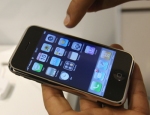Touch Screens – The Current Revolution
Graphic User Interfaces (GUI’s) have evolved from the point and click mouse of the 80’s to a point and touch revolution of the twenty-first century. The touch screen advances the human user interface with more compelling and well – a more human experience. From our earliest explorations as a child we have explore our world through touch and feel. Building on this visceral experience, the touch screen feels more like what we think of as a normal human interface. In this blog lets explore the technology that makes touch screens possible ending with a glimpse of cutting edge user interfaces just hitting the market.
Electronic devices can use lots of different methods to detect a person’s input on a touch-screen. Most of them use sensors and circuitry to monitor changes in a particular state. Many, including the iPhone, monitor changes in electrical current. Others monitor changes in the reflection of waves. These can be sound waves or beams of near infra-red light. A few systems use transducers to measure changes in vibration caused when your finger hits the screen’s surface or cameras to monitor changes in light and shadow.
The basic idea is pretty simple — when you place your finger or a stylus on the screen, it changes the state that the device is monitoring. In screens that rely on sound or light waves, your finger physically blocks or reflects some of the waves. Capacitive touch-screens use a layer of capacitive material to hold an electrical charge; touching the screen changes the amount of charge at a specific point of contact. Inresistive screens, the pressure from your finger causes conductive and resistive layers of circuitry to touch each other, changing the circuits’ resistance.
Touch-screen monitors have become more and more commonplace as their price has steadily dropped over the past decade. There are three basic systems that are used to recognize a person’s touch:
- Resistive
- Capacitive
- Surface acoustic wave
The resistive system consists of a normal glass panel that is covered with a conductive and a resistive metallic layer. These two layers are held apart by spacers, and a scratch-resistant layer is placed on top of the whole setup. An electrical current runs through the two layers while the monitor is operational. When a user touches the screen, the two layers make contact in that exact spot. The change in the electrical field is noted and the coordinates of the point of contact are calculated by the computer. Once the coordinates are known, a special driver translates the touch into something that the operating system can understand, much as a computer mouse driver translates a mouse’s movements into a click or a drag.
In the capacitive system, a layer that stores electrical charge is placed on the glass panel of the monitor. When a user touches the monitor with his or her finger, some of the charge is transferred to the user, so the charge on the capacitive layer decreases. This decrease is measured in circuits located at each corner of the monitor. The computer calculates, from the relative differences in charge at each corner, exactly where the touch event took place and then relays that information to the touch-screen driver software. One advantage that the capacitive system has over the resistive system is that it transmits almost 90 percent of the light from the monitor, whereas the resistive system only transmits about 75 percent. This gives the capacitive system a much clearer picture than the resistive system.
On the monitor of a surface acoustic wave system, two transducers (one receiving and one sending) are placed along the x and y axes of the monitor’s glass plate. Also placed on the glass are reflectors — they reflect an electrical signal sent from one transducer to the other. The receiving transducer is able to tell if the wave has been disturbed by a touch event at any instant, and can locate it accordingly. The wave setup has no metallic layers on the screen, allowing for 100-percent light throughput and perfect image clarity. This makes the surface acoustic wave system best for displaying detailed graphics (both other systems have significant degradation in clarity).
-
Archives
- October 2010 (1)
- May 2010 (1)
- April 2010 (1)
- March 2010 (1)
-
Categories
-
RSS
Entries RSS
Comments RSS

